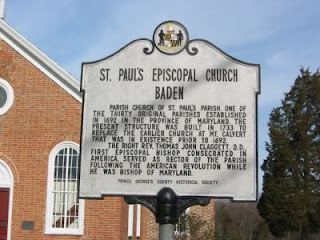 |
| Bishop Claggett |
Thomas John Claggett, the son of the Rev. Samuel Claggett and Elizabeth Gantt, was born 3 October 1743 in Nottingham, Prince George's County MD. Our shared ancestor is Captain Thomas Clagett, my 10X great-grandfather.
 |
| Archbishop Carroll |
John Carroll, the son of Daniel Carroll and Eleanor Darnall, was born in Upper Marlboro, Prince George's County MD 8 January 1735. Our shared ancestor is Col. Henry Darnall, my 7X great-grandfather.
When Thomas John Claggett's father died in 1756, the young man was placed in the care of his maternal uncle, the Rev. John Eversfield and later attended the Lower Marlboro Academy, founded by Eversfield. At age 17, he entered the College of New Jersey (now Princeton) and graduated in 1764. He continued his theological training with Rev. Eversfield for three more years. He was ordained by the Bishop of London in 1767 and upon returning to Maryland, was appointed rector of All Saints Church in Calvert County MD. While he was in England, he also studied the family history and added the second “g” to his name to go back to its historical roots.
In 1773, he married Mary Gantt, the daughter of Captain Edward Gantt and Elizabeth Wheeler. The Claggetts had three sons--Thomas John, Samuel and Charles--and three daughters--Mary, Elizabeth, and Priscilla.
The Revolutionary War created tremendous conflicts for Anglican clergy. Having been ordained in England, they had all taken oaths of loyalty to the king and did not feel they could sign an oath of fidelity to America. The number of clergy dwindled sharply as many gave up their congregations to return to England, or retired to their estates, or took up teaching instead of ministry. Rev. Claggett avoided the conflict by retiring to his estate in Prince George's County. In 1780, he took up ministry again becoming
the rector of his uncle's parish, St. Paul's in Baden, Prince George's County. He later became the rector of St. James Parish in Anne Arundel County. In 1810, he became the first rector of the newly founded Trinity Church in Upper Marlboro.
In 1789, unable to get bishops consecrated by the Church of England, American Anglicans formed a new independent church--The Protestant Episcopal Church in the United States of America. Thomas John Claggett was chosen as the first bishop of Maryland in 1792.
Bishop Claggett died at his home in Croom, Prince George's County MD, in 1816 and was originally buried in the family plot there. In 1898, his remains were removed to the National Cathedral, just being constructed in Washington DC.
Bishop Claggett's epitaph was written by his friend Francis Scott Key:
He ruled the church with firmness and faithfulnessand adorned it by his character.He left a beloved memory to his wife,his children and his friends and honored name to his country and the church.
John Carroll was schooled at home by his mother before being sent to a Jesuit school at Bohemia Manor in northeast Maryland. At the age of 13, he was sent to France, along with his cousin, Charles Carroll (signer of the Declaration), to study at the College of St. Omer, founded specifically to educate Catholics after the Protestant Reformation in England under Henry VII.
Carroll joined the Society of Jesus (Jesuits) in 1753 at age 18 and was ordained in 1769 at the age of 34. He taught philosophy and theology at St. Omer until, in 1773, the Jesuits were suppressed in Europe, and Carroll returned to Maryland. Because of laws discriminating against Catholics in Maryland, there was no public Catholic Church there. Carroll worked as a missionary in Maryland and Virginia, making his home with his elderly mother at the family estate.
In 1784, Pope Pius VI appointed John Carroll as "provisional superior of the Missions in the thirteen United States of America." The Pope did this at least in part because he wanted to please Ambassador Benjamin Franklin, who had warmly recommended Carroll. In 1789, the priests of Maryland petitioned Rome to create a Bishop, and John Carroll was chosen as Bishop of the Diocese of Baltimore, which at the time encompassed most of the Eastern United States.
One of Bishop Carroll's first concerns was education, and in 1791, he orchestrated the founding of Georgetown College in the newly designated national capital, the District of Columbia. For the training of priests, he likewise organized the nucleus of St. Mary's Seminary in Baltimore MD.
In 1806, Bishop Carroll oversaw the construction of the first cathedral in the United States, the Basilica of the Assumption in Baltimore, working with Benjamin Henry Latrobe on the design. Carroll laid the cornerstone but did not live to see the cathedral completed. Architecturally, the Basilica is considered Latrobe's masterpiece.
In 1808, Carroll was made Archbishop with jurisdiction over the newly created dioceses of Boston, New York, Bardstown and Philadelphia as well as Baltimore.
Archbishop Carroll died in Baltimore in 1815 at the age of 80 and was interred at the Basilica in 1824 once it was opened for use.
Carroll was an early advocate for the use of the vernacular in Catholic liturgy but was unable to get support for this among the hierarchy.
During his years as head of the American church, the Roman Catholic population grew from 25,000 to 200,000.
Both of my clerical cousins gave many years of loving service to the spiritual needs of the people of Maryland. I am happy to light this little candle in their memory.




No comments:
Post a Comment